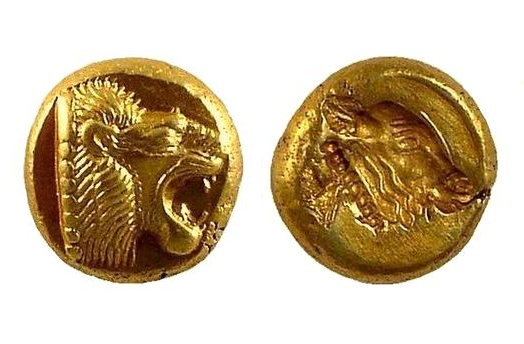
about ancient nomos
Ancient Nomos Art is a museum of galleries exhibiting ancient coins and ancient mint maps. The coin gallery displays the diverse art and history of hand-crafted ancient Greek, Roman, Byzantine, Persian and Medieval coinage. The ancient mints mapping gallery features Greek, Roman, Byzantine, Asia Minor and Medieval mint city regions and territories. Visitor's are welcome to explore, study and enjoy Ancient Nomos Art.

Greek, Lesbos – 478 BC
Mytilene, Lesbos
From Ancient Galleries

Obverse: Head of roaring Lion facing right.
Reverse: Incuse head of Cow facing right.
LEGEND SYMBOLS
Obv: Head of roaring Lion facing right Rev: Incuse head of Calf’s head facing right with rectangular punch behind.
The ancient Greek island of Lesbos is located in the northeastern Aegean Sea off the coast of modern day Turkey, and is separated by the Gulf of Edremit. The southern coastal city of Mytilene was the island’s largest and wealthiest city. The city produced vast quantities of gold hektai during the late 6th century BC in part to subsidize the neighboring Persia Empire and later the Delian League. Historians believe Mytilene was founded in the 11th century by Penthilidae of Thessaly, whose descendents governed the city until 580 BC. The archaic “roaring lion” coins of Lesbos were minted shortly after the island became a Persian subject following Cyrus’s defeat of Croesus in 546 BC. Consequently, Persian influence likely determined the Greek islands choice of Lion motif as the featured design emblem signifying Lesbos. This archaic Lesbian coin represents an important technical development and evolutionary link to the earliest man-made coins of Ionia (see Ionia electrum), just a century earlier. The obverse sculptural relief design coupled with the incuse intaglio engraved reverse demonstrates the use of two animal forms in a single, gem-like piece. The art work of this magnificent archaic hekte demonstrates miniature detailing at its finest. The detailed roaring lion obverse is known to be a popular ancient Persian symbol of kings and stateliness, while also symbolizing an Empires bravery, warning and power when roaring. The incuse Calf’s head reverse is thought to be the actual emblem of the city Mytilene, and is both a Greek and Persian symbol. This sophisticated die engraving cleverly couples two animal motifs onto one coin, sacred symbols shared by Greece and Persia, at a time when Lesbos balanced allegiances between regions. Lesbian coinage remained in widespread circulation throughout the Ionian region for the next two centuries.
DOCUMENTATION
Value: Hekte. Metal: Electum. Weight: 2.53 grams. Mint: Mytilene, Lesbos. Date: 521-478 BC.
Attribution: Bodenstedt Em. 13 (unlisted dies); Sylloge Nummorum Graecorum (SNG) Copenhagen 301; SNG von Aulock 1685; BMC 18-22; Boston MFA 1679-81; Gulbenkian 874-5; Pozzi 2315-6; Weber, Plate 200, 5605.
Legend, Documentation and Attribution
